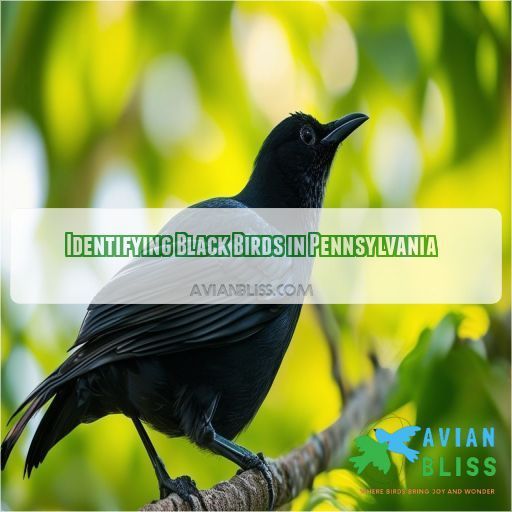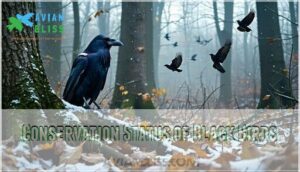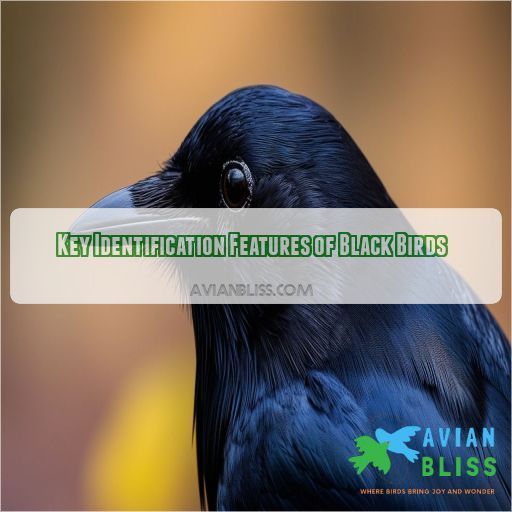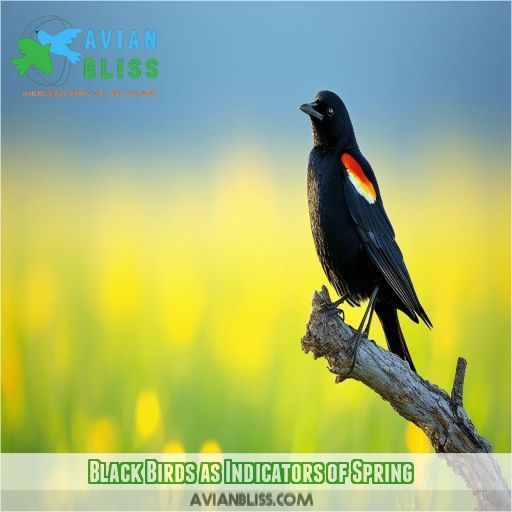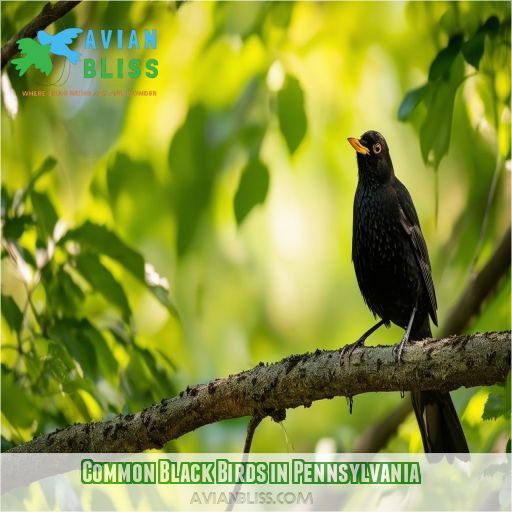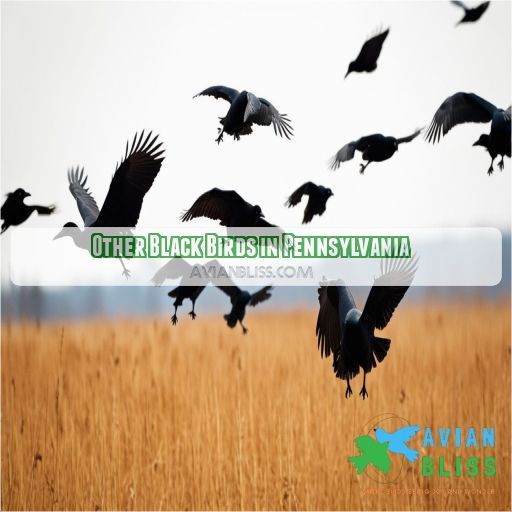This site is supported by our readers. We may earn a commission, at no cost to you, if you purchase through links.
 You’re wondering about black birds in Pennsylvania, huh?
You’re wondering about black birds in Pennsylvania, huh?
Well, there’s a few species you might spot.
The American crow, for one, is an all-black bird with long legs and a long bill. You’ll find these guys in open woodlands, hanging around all year.
Then there’s the red-winged blackbird, with the males sporting bright red and yellow patches. These fellas like marshes and can also be spotted year-round.
Another one to look out for is the American robin, with its dark head and back. Keep an eye out for those white spots around their eyes—they’re a dead giveaway.
Table Of Contents
- Key Takeaways
- Identifying Black Birds in Pennsylvania
- Habitat and Diet of Black Birds
- Conservation Status of Black Birds
- Birdwatching Adventures in Pennsylvania
- Key Identification Features of Black Birds
- Black Birds as Indicators of Spring
- Wildlife Breeding Season
- Common Black Birds in Pennsylvania
- Other Black Birds in Pennsylvania
- Share Your Thoughts and Ask an Expert
- Frequently Asked Questions (FAQs)
- What is the common black bird in Pennsylvania?
- What is the most common bird in Pennsylvania?
- Can you shoot grackles in Pennsylvania?
- What birds are usually all black?
- Are blackbirds a sign of spring?
- What should I do if I find a fawn?
- Where do blackbirds live?
- What do blackbirds eat?
- Are blackbirds endangered?
- Conclusion
Key Takeaways
- Pennsylvania is home to a diverse range of black bird species, from the vibrant Yellow-headed Blackbird to the ubiquitous American Crow.
- Birdwatchers can spot these feathered friends in wetlands, grasslands, and even their own backyards, with some species migrating and others residing in the state all year round.
- Black birds are omnivores with a taste for insects, seeds, grains, fruits, and berries, and they’re not afraid to visit bird feeders for an easy meal.
- While blackbirds aren’t currently endangered, their populations are declining due to habitat loss and climate change, so conservation efforts are important to protect these fascinating birds for the future.
Identifying Black Birds in Pennsylvania
If you’re a birdwatcher in Pennsylvania, you’ve probably encountered black birds. But can you tell a Red-winged Blackbird from a Brewer’s Blackbird? In this guide, we’ll help you identify eight species of black birds commonly found in the Keystone State.
Yellow-headed Blackbirds
Yellow-headed blackbirds are a rare treat for birdwatchers in Pennsylvania.
Their striking yellow heads and black bodies make them easily identifiable.
Males sport bright yellow heads and white wing patches, while females have duller yellow heads and brown bodies.
These medium-sized songbirds are known for their "chuck" or "chirp" call.
Keep an ear out for this distinctive sound as you scan the wetlands and grasslands they favor.
Red-winged Blackbirds
Red-winged blackbirds are a sure sign of spring in Pennsylvania. Keep an eye out for the males with their bright red wing patches, while females and juveniles sport duller brown feathers with dark streaks. Listen for their unique mating calls and songs, and you’ll likely spot these common birds during breeding season.
Common Grackles
Common grackles are abundant in Pennsylvania, and you can spot them in various habitats, from wetlands to backyards. These birds are medium-sized with a long tail, and their behavior is often described as bold and noisy.
Males have a glossy black body with a purple sheen, while females are more subdued with a darker brown body. Keep an eye out for their bright yellow eyes—a distinctive feature.
Grackles are omnivores, feasting on insects, seeds, and even your backyard bird feeder. They’re social birds, often gathering in large flocks, so you’re likely to spot them in numbers.
Brown-headed Cowbirds
Brown-headed cowbirds are medium-sized with a brown head, black body, and short tail. They’re often seen in large flocks with other blackbird species, like the red-winged blackbird.
These birds are known for their parasitic nesting behavior, laying their eggs in the nests of other birds.
You’ll spot them foraging for food in fields and grasslands.
European Starlings
European starlings are common black birds you might spot in Pennsylvania.
They’re part of the diverse blackbird flocks that attract birdwatchers to the state.
While not native to the US, they’ve become a familiar sight across the country.
Keep an eye out for their iridescent dark plumage, yellow beaks, and social behavior.
You’ll often find them in large groups, perching on wires or in fields, adding a touch of sparkle to the Pennsylvania landscape.
Habitat and Diet of Black Birds
Now that you know how to identify black birds in Pennsylvania, let’s take a closer look at their natural habitats and favorite meals. Wetlands and grasslands are like home to these birds, and they’re always on the lookout for a tasty treat of insects, seeds, grains, fruits, or berries.
Wetlands and Grasslands
Black birds, such as the Yellow-headed Blackbird, are typically drawn to wetlands and grasslands.
These habitats offer the ideal environment for these birds to nest and forage for food.
Wetlands, with their tall grasses and cattails, provide the perfect cover for blackbirds to build their nests and raise their young.
Grasslands, on the other hand, offer ample space for these birds to roam and search for insects, seeds, and grains.
Omnivorous Diet
Black birds are omnivores, which means they eat a variety of foods. They’re not picky eaters and will happily feast on whatever’s available. You might spot them foraging in fields and meadows, sampling the local cuisine.
Insects, Seeds, and Grains
Black birds in Pennsylvania have diverse diets. While they’re omnivores, they’re big fans of insects, seeds, and grains. You might spot ’em pecking at bird feeders or foraging in fields and meadows.
Take the Yellow-headed Blackbird, for instance. This fella loves himself some insects, seeds, and grains, especially during the chilly winter months when bird feeders are a tasty treat.
Fruits and Berries
Besides insects, seeds, and grains, blackbirds in Pennsylvania also feast on fruits and berries. Think of these colorful treats as nature’s candy, packed with vitamins and antioxidants. It’s like watching a bunch of kids in a candy store, except these birds are way more graceful.
Imagine an eastern bluebird with its vibrant blue feathers, gobbling up some juicy berries. Or a gray catbird, similar in size to an American goldfinch, pecking at ripe fruits. It’s a colorful feast that adds a touch of fun to the already interesting world of birdwatching.
Conservation Status of Black Birds
While birdwatching is an enjoyable pastime, it’s important to be aware of the conservation status of the birds you’re observing. Some black bird species in Pennsylvania are facing population declines, and understanding the challenges they face is key to protecting them.
Declining Populations
While blackbirds aren’t currently considered endangered, their populations are in decline. This is a cause for concern and highlights the importance of conservation efforts to protect these birds for future generations. Bird conservation is a complex issue, and it’s important to understand the threats facing these birds and take action to help them thrive.
Habitat Loss
Habitat loss poses a significant threat to black birds in Pennsylvania, with their wetland and grassland habitats increasingly under pressure. This loss of natural habitats directly impacts species like the American crow, black vulture, turkey vulture, and barred owl, pushing them into closer contact with human populations.
Climate Change
Climate change is a double whammy for black birds, adding to the challenges they face due to habitat loss. It’s a one-two punch that’s impacting populations across the board. As temperatures rise, their wetland habitats are shrinking, and food sources are becoming scarcer.
Protecting Wetlands
The conservation status of black birds in Pennsylvania is a pressing issue, and protecting their wetland habitats is really important. Here’s why:
- Declining Populations: Populations of black birds, including the Yellow-headed Blackbird, are in decline.
- Habitat Loss: Habitat loss is a major threat, so it’s important we protect the wetlands they call home.
- Climate Change: Climate change is also impacting their numbers.
You can play a part in protecting these birds by supporting organisations dedicated to wetland conservation.
Birdwatching Adventures in Pennsylvania
Whether you’re a seasoned birdwatcher or a novice, Pennsylvania offers exciting birdwatching adventures. From the rare Yellow-headed Blackbird to the elusive Brewer’s Blackbird, get ready to explore diverse habitats and spot some stunning blackbird species.
Yellow-headed Blackbird Sighting
Birdwatching in Pennsylvania can lead to some exciting moments, especially when you spot a rare bird like the Yellow-headed Blackbird. This striking bird isn’t commonly seen in the state, so a sighting is a real treat. Imagine the thrill of spotting one of these vibrant birds with its bright yellow head and black body!
| Species | Male | Female |
|---|---|---|
| Yellow-headed Blackbird | Bright yellow head, black body, white wing patches | Duller yellow head, brown body |
Blackbird Bonanza in Southern Lancaster
Birdwatchers in southern Lancaster County, PA, were in for a treat during the winter months. They set out on a mission to spot the elusive Yellow-headed Blackbird and weren’t disappointed.
- The Yellow-headed Blackbird Encounter: Birdwatchers successfully spotted multiple Yellow-headed Blackbirds, identifiable by their bright yellow heads and white wing patches. These birds are often found in large flocks foraging in farm fields.
- A Flock of Diversity: The blackbird flock contained an impressive variety of species, including Brown-headed Cowbirds, Red-winged Blackbirds, Common Grackles, and European Starlings. The sheer number of birds, estimated at over 60,000, was a sight to behold.
- Raptor Attraction: The diverse flock attracted a range of raptors, including Bald Eagles, Cooper’s Hawks, Red-tailed Hawks, and American Kestrels. Birdwatchers also observed a large number of Ring-billed Gulls.
- Community and Conservation: The birdwatchers shared their exciting experience and observations online, encouraging others to explore the area and contribute to birdwatching data. Documenting bird sightings helps raise awareness about the importance of bird conservation and fosters a sense of community among bird enthusiasts.
Stay tuned for more birdwatching adventures in Pennsylvania as we continue our quest to identify black birds in the Keystone State.
The Elusive Brewer’s Blackbird
Brewer’s Blackbirds are a rare sight in Pennsylvania, so birdwatchers are always on the lookout for them. These birds share similarities with other blackbird species, making identification a challenge. Their rarity in the area and the timing of observations may impact the chances of spotting them. Keep your eyes peeled and don’t give up—they’re out there!
The Diverse Blackbird Flock
Birdwatching in Pennsylvania offers a chance to witness the incredible diversity of blackbird flocks. These flocks are a sight to behold, with thousands of birds gathering together, each with their unique characteristics. Here’s what you need to know about these diverse blackbird flocks:
- Species Variety: The blackbird flock includes a mix of species like Brown-headed Cowbirds, Red-winged Blackbirds, Common Grackles, and more, each with distinct features.
- Abundance: With an estimated 60,000+ blackbirds, the flock showcases the ideal habitat and abundant food sources.
- Raptor Attraction: The diverse blackbird flock attracts raptors like Bald Eagles and hawks, highlighting the complex food web and ecological relationships.
Key Identification Features of Black Birds
Now that you know where and when to spot black birds, let’s take a closer look at the key identification features of these feathered friends. From their physical traits to behavioral quirks, we’ll explore what makes each species unique and how to tell them apart.
Yellow-Headed Distinction
The Yellow-headed Blackbird is a striking bird that’s relatively easy to identify. Its bright yellow head and black body make it stand out, especially when it’s in flight. This medium-sized songbird has a long tail, and its colors are vivid and unmistakable.
| Gender | Description |
|---|---|
| Male | Bright yellow head, black body, and white wing patches. |
| Female | Duller yellow head and brown body. |
The Yellow-headed Blackbird’s call is also distinctive, often described as a "chuck" or "chirp." This bird is a treat for birdwatchers, especially in Pennsylvania, where sightings are uncommon but becoming more frequent.
Blackbird Behaviour
When you start watching birds, you’ll notice that blackbirds have some pretty cool behaviors that make them fun to study. Here are a few things to keep in mind:
- Social Gatherings: Blackbirds often hang out in big groups, especially during the winter. This keeps them safe and gives them a chance to socialize.
- Foraging Strategies: They’re not picky eaters and are good at finding food. They eat insects, seeds, grains, fruits, and berries. You might see them looking for food in fields, meadows, or even at bird feeders in the winter.
- Nesting Preferences: Blackbirds like to build their nests in wetlands and grasslands, especially places with tall grasses and cattails. These places give them the cover and resources they need to raise their young.
- Migration Patterns: Some blackbird species stay in the same place all year, but others fly to warmer places during the colder months. Pay attention to where you see them throughout the year.
Spotting Challenges
Despite their distinctive features, black birds can still pose identification challenges, especially when differentiating between similar species. Here are some tips to help:
- Focus on key marks: size, shape, behavior, unique markings.
- Use guides/apps for detailed illustrations and descriptions.
- Observe behavior: foraging, perching, soaring habits and habitats.
- Consider location and seasonality for species prevalence.
- Listen for unique calls and songs.
Black Birds as Indicators of Spring
While the calendar marks the official arrival of spring, the presence of certain birds can be an even more telling sign. Keep an eye out for the American Robin, a migratory bird often associated with the onset of spring, and the Red-winged Blackbird, with its distinctive red wing patch, as these birds can signal that warmer days are ahead.
American Robins
While the calendar marks the official arrival of spring, the presence of certain birds can be an even more reliable indicator.
The American Robin is often regarded as the first migrating bird of spring, but the truth is a bit more complex.
Some robins stick around the Northeast all year, so their presence doesn’t always signify the changing seasons.
Their migration patterns can be similar to those of the red-winged blackbird, adding to the confusion.
Keep an eye out for these playful, curious birds as they herald the arrival of spring.
Spring’s Arrival
Spring’s arrival is heralded by the appearance of certain birds, acting as indicators of the changing seasons. While the calendar marks the official start of spring, these feathered friends offer a more reliable and exciting sign. Here’s how you can use blackbirds as a signal that spring is here:
- Red-winged Blackbird: Keep an eye out for the male Red-winged Blackbird, easily identified by his vibrant red wing patch. He’s the true harbinger of spring, often arriving up to two weeks before the females.
- American Robin: While some American Robins can be year-round residents in the Northeast, the arrival of migrating robins is often associated with the start of spring.
- Listen for Songs: Keep your ears open for the cheerful tunes of the Tufted Titmouse, Carolina Chickadee, and White-throated Sparrow. Their songs will fill the air as they return to Pennsylvania for the spring breeding season.
Wildlife Breeding Season
As spring arrives, it’s not just the birds that are busy. For many Pennsylvania wildlife species, breeding season is already in full swing by mid-April to May. This means you might spot some adorable young wildlife, like fawns, opossums, and baby birds. Remember to give them space and observe from a distance—let them grow and develop undisturbed.
Fawn Rescue
If you spot a fawn, it’s important to remember that most of the time, they don’t need rescuing. Fawns are experts at staying still and hiding, even in seemingly unsafe places. Their mother is likely nearby, waiting for you to leave so she can return.
Only if you see a fawn near its deceased mother should you contact the game commission for help. Otherwise, keep your distance and let nature take its course.
Wildlife Rehabilitation
Rehabilitation centers are a lifeline for injured or orphaned wild animals, providing treatment and care so they can return to their natural habitats.
These centers play a key role in wildlife conservation, ensuring that animals remain wild and can be released back into nature.
If you come across injured wildlife, contact your local rehabilitation center for guidance on ethical treatment and recovery.
Spring’s Renewal
Spring’s renewal brings a sense of hope and appreciation for nature. As the season unfolds, it’s a perfect time to observe wildlife, whether birds or mammals. Keep an eye out for young wildlife, such as fawns and opossums, as they start to appear in mid-April and May. Remember to give them space to grow and develop naturally.
Common Black Birds in Pennsylvania
Pennsylvania is home to a variety of black bird species, some more common than others. Here are a few black birds that you’re likely to spot on your birdwatching adventures:
- Red-winged Blackbirds: These birds are a well-known sign of spring in Pennsylvania. The males are easily identified by their red wing patches, while females and juveniles are dull brown with dark streaks. Keep an eye out for them during the early days of spring.
- American Robins: While some robins stick around in the Northeast year-round, the arrival of migrating robins is often associated with the start of spring. They’re a common sight in Pennsylvania, so you’re likely to spot them throughout the state.
- Brown-headed Cowbirds: These blackbirds are commonly found in large flocks and are often seen foraging in farm fields. They’re one of the most abundant black bird species in the area, so you’ll have plenty of opportunities to spot them.
- Common Grackles: Another species that’s frequently seen in Pennsylvania, especially in urban and suburban areas. They’re larger than other blackbirds and have a distinctive long tail.
These are just a few examples of the common black birds you can expect to see in Pennsylvania. Each species has its own unique characteristics, behaviors, and habitats, so keep an eye out and you’ll soon become an expert at identifying them!
Other Black Birds in Pennsylvania
While you’re out birdwatching, keep your eyes peeled for other black bird species that call Pennsylvania home. In this section, we’ll introduce you to four less commonly spotted black birds that you might just get lucky enough to see.
Rusty Blackbirds
Rusty Blackbirds are another species of black birds that can be found in Pennsylvania. Their range extends beyond the state, but they’re known to frequent wetlands and wooded areas during migration and breeding seasons. Their habitat preferences include wetlands and wooded areas, especially those with standing water and dense vegetation.
The diet of Rusty Blackbirds consists of a variety of items. They’re known to feed on insects, snails, and other invertebrates, as well as seeds and berries.
While not currently considered endangered, Rusty Blackbirds face similar conservation challenges to other blackbird species, including habitat loss and the impacts of climate change.
Common Ravens
Common Ravens are large, all-black birds with a majestic presence.
They’re often mistaken for American Crows due to their similar appearance, but there’s a few key differences.
Ravens are the bigger bird, with a heavier bill and shaggy throat feathers.
Listen out for their deep, croaking calls – they sound like a low, gravelly "kronk."
These ravens are adaptable and can be found in a variety of habitats, from forests to deserts.
Black Vultures
Black vultures are another species of black bird you might come across in Pennsylvania. Here are some key aspects to know about them:
- Flight Patterns: Black vultures soar with their wings in a slight dihedral, or V-shape, and often fly in groups or "kettles."
- Scavenging Habits: These birds are nature’s clean-up crew, feeding primarily on carrion and scavenging for food.
- Social Structure: They’re social birds, often gathering in large groups at roosting sites.
- Conservation Efforts: While black vultures aren’t currently considered endangered, it’s important to protect their habitats and food sources to help keep their populations healthy.
Fish Crows
Fish crows are wetland birds found in the eastern and southeastern United States, from Rhode Island to the Gulf of Mexico.
They frequent coastal marshes, beaches, rivers, inland lakes, and river banks.
Since 2012, they’ve expanded their range into Canada, with breeding populations along Lake Ontario.
Fish crows are omnivores, eating everything from small crustaceans and fish to fruits, grains, and even human scraps.
There are no major threats to this species at present, and their numbers are increasing.
Share Your Thoughts and Ask an Expert
We want to hear about your birdwatching adventures! Share your experiences, stories, and photos of black birds you’ve spotted in Pennsylvania. Also, if you have any questions about black bird identification, habitat, or conservation, feel free to reach out to birdwatching experts for guidance.
Share Your Birdwatching Experience
Now it’s your turn to share your birdwatching adventures! Have you spotted any of these blackbird species in Pennsylvania or other locations? What were your experiences like? Did you face any challenges in identifying them or spotting them in the wild?
Feel free to share your stories, photos, and observations in the comments. Let’s create a community of bird enthusiasts who can learn from each other and appreciate the beauty of these feathered friends together.
Ask an Expert About Black Birds
Got a burning question about blackbirds?
Or maybe you’ve had a sighting you can’t quite make sense of.
Don’t worry; we’re here to help.
Head over to our forums and ask our friendly community of bird experts.
They’ll be happy to help and share their knowledge.
Frequently Asked Questions (FAQs)
What is the common black bird in Pennsylvania?
Imagine you’re strolling through Pennsylvania’s lush landscapes, keeping an eye out for a familiar black-feathered friend. Well, you’re in luck! You’re likely to spot the American Crow, a bird as versatile as it’s common, adapting to almost any habitat.
What is the most common bird in Pennsylvania?
The Northern Cardinal is Pennsylvania‘s most frequently spotted bird, featuring on 50% of bird-watching lists. Other common birds include the Downy Woodpecker, House Wren, and Black-capped Chickadee.
Can you shoot grackles in Pennsylvania?
While grackles are a nuisance, it’s not that simple. Before you shoot, check with city officials. The Migratory Bird Treaty Act of 1918 protects birds, but there might be a provision for destroying pest grackles.
What birds are usually all black?
Crows, ravens, grackles, starlings, cowbirds, and swifts are some of the bird species that are usually all black or mostly black.
Are blackbirds a sign of spring?
Birders consider the Red-winged Blackbird a sign of spring. These birds are among the first to migrate back from their southern winter homes. One source mentions that since the 1970s, they’ve been arriving earlier, possibly due to climate change.
What should I do if I find a fawn?
If you find a fawn, don’t touch it or get too close. The mother won’t return if she senses humans. Keep your distance and monitor the fawn. If it’s in immediate danger, call a wildlife centre.
Where do blackbirds live?
Like bees to honey, blackbirds are drawn to gardens, forests, and grasslands. These birds are versatile, flocking across the globe, from the UK to North and South America.
What do blackbirds eat?
Blackbirds eat worms, insects, and fruit. They’ll also eat seeds, berries, and even kitchen scraps like raisins, cut-up pears, and porridge oats.
Are blackbirds endangered?
Blackbirds aren’t currently endangered, but their populations are stable. However, they’ve declined in recent years due to poor food availability and changes in agriculture. So, keep sharing those mealworms and suet pellets to support these birds.
Conclusion
Pennsylvania’s black birds offer a fascinating glimpse into nature’s diversity.
From the ubiquitous American crow to the vibrant red-winged blackbird, these species showcase unique traits and habitats.
As you venture out, keep an eye out for the distinctive features of each bird, from the yellow-headed blackbird’s vibrant crown to the common grackle’s iridescent plumage.

